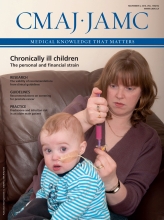Dextromethorphan is more than an innocuous antitussive
At large doses used recreationally (300 to > 1500 mg), dextromethorphan and its metabolite dextrophan block N-methyl-d-aspartate receptors, producing dissociative effects similar to those of phencyclidine and ketamine.1 Neurobehavioural effects can begin within one hour after ingestion, are dose-related and are described by users as occurring in “plateaus” (Box 1).2,3 Adrenergic effects (e.g., hypertension, diaphoresis) can result from dose-related inhibition of catecholamine reuptake, and serotonergic effects can result from agonist effects at serotonin receptors.4 Serotonin syndrome can also arise from interactions with serotonergic drugs.2,3
“Plateaus” of dextromethorphan toxicity*,2,3
Plateau 1 (1.5–2.5 mg/kg)
-
Total intake 100–200 mg (4–6 capsules or 35–60 mL of syrup)
-
Restlessness, euphoria
Plateau 2 (2.5–7.5 mg/kg)
-
Total dose 200–500 mg (7–18 capsules or 60–185 mL of syrup)
-
Exaggerated auditory and visual sensations, closed-eye hallucinations, imbalance
Plateau 3 (7.5–15 mg/kg)
-
Total dose 500–1000 mg (18–33 capsules or 185–375 mL of syrup)
-
Visual and auditory disturbances, altered consciousness, delayed reaction times, mania, panic, partial dissociation
Plateau 4 (> 15 mg/kg)
-
Total dose > 1000 mg (> 33 capsules or > 375 mL of syrup)
-
Hallucinations, delusions, ataxia, complete dissociation
-
↵* Assuming a 75-kg person, 30-mg capsules and 3 mg per millilitre of syrup.
Use is increasing among adolescents
According to the Ontario Student Drug Use and Health Survey, 9.7% of students in grades 7 to 12 reported using dextromethorphan recreationally in 2013, compared with 6.9% in 2011.5 Most dextromethorphan-related calls to poison control centres involve adolescent males and solid dose formulations of the drug.6
Clinical effects may be influenced by combined-formulation drugs
Some effects attributed to dextromethorphan may reflect ingestion of combination drugs, particularly decongestants, acetaminophen and anticholinergic antihistamines.2,4 Because dextromethorphan is not detected by basic drug screens, toxicity secondary to its use should be considered when evaluating patients with a dissociative toxidrome.2,4
Treatment is supportive
No specific antidote exists for dextromethorphan toxicity.3,5 Guidelines suggest benzodiazepines for seizures and aggressive cooling measures for hyperthermia. Naloxone can be considered for use in patients in a coma or with respiratory depression, although clinical response is varied.2,4 Acetaminophen levels should be obtained when concomitant ingestion is suspected, and additional measures for the management of associated complications (e.g., delayed hepatic injury related to acetaminophen overdose) implemented as appropriate.2,4
Withdrawal can occur
Anecdotal reports from long-term users (i.e., months to years) have described intense cravings, flashbacks and hallucinations within three days after stopping dextromethorphan.2,3 Physical symptoms of withdrawal include diarrhea, vomiting and rigors. Symptoms typically resolve within two days without specific treatment.1
Footnotes
-
Competing interests: None declared.
-
This article has been peer reviewed.











